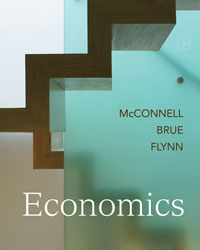
Economics (McConnell), 18th EditionChapter 4: The U.S. Economy: Private and Public SectorsKey Questions1. Assume that the five residents of Econoville receive incomes of $50, $75, $125, $250, and $500. Present the resulting distribution of income as a graph similar to Figure 4.2. Compare the incomes of the lowest fifth and the highest fifth of the income receivers. 2. What are the three major legal forms of business organization? Which form is the most prevalent in terms of numbers? Why do you think that is so? Which form is dominant in terms of total sales? What major advantages of this form of business organization gave rise to its dominance? 3. What are the two characteristics of public goods? Explain the significance of each for public provision as opposed to private provision. What is the free-rider problem as it relates to public goods? Is U.S. border patrol a public good or a private good? Why? How about satellite TV? Explain. 4. Draw a production possibilities curve with public goods on the vertical axis and private goods on the horizontal axis. Assuming the economy is initially operating on the curve, indicate how the production of public goods might be increased. How might the output of public goods be increased if the economy is initially operating at a point inside the curve? 5. Suppose in Fiscalville there is no tax on the first $10,000 of income, but a 20 percent tax on earnings between $10,000 and $20,000 and a 30 percent tax on income between $20,000 and $30,000. Any income above $30,000 is taxed at 40 percent. If your income is $50,000, how much will you pay in taxes? Determine your marginal and average tax rates. Is this a progressive tax? Explain. |  |















